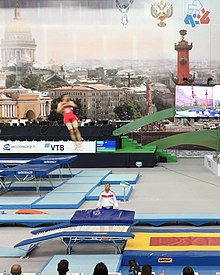 9 Time World Double Mini Trampoline Champion Mikhail Zalomin, at the 2018 World Championships | |
| Highest governing body | International Gymnastics Federation |
|---|---|
| Characteristics | |
| Team members | Individuals or Teams of 3 or 4 |
| Mixed-sex | No |
| Type | Gymnastic sport |
| Presence | |
| Country or region | Worldwide |
| Olympic | No |
| World Games | 2001 – 2022 |
Double mini trampoline, sometimes referred to as double mini or DMT, is a gymnastics discipline within trampolining. Participants perform acrobatic skills on an apparatus smaller than a regular competition trampoline. The apparatus has both an angled section and a flat section.[1] Unlike individual trampoline, where scoring is predominantly determined by Execution, Time of Flight and Difficulty, the Difficulty in DMT plays a more prominent role in the final score.
A DMT routine or pass consist of two phases. The first phase is called a "mount"; during this phase the athlete jumps onto the angled part and flips off of it onto the flat part. The first phase can also be performed by jumping, without flips or twist, onto the flat part and then commencing the first flip or twist. In this case the first phase is called a "spotter". The second phase starts on the flat part and is called a "dismount"; the athlete lands the first flipping sequences from phase one and immediately launches into a second series of flips and twists before landing on a mat.[1]
The athletes are judged on Difficulty and Execution.[2] There are both Individual and Team competitions in the sport.[1]
DMT is governed by the FIG, the International Federation of Gymnastics, and is included as an event within Trampoline Gymnastics. Although not an Olympic event yet, Elite DMT athletes compete at International level and can compete in various events organised by the FIG as well as at the World Games.
- ^ a b c "FIG - Discipline". www.gymnastics.sport. Retrieved 15 January 2021.
- ^ Trampoline Codes of points (COP). "APPENDIX to the CODES of POINTS (COP)" (PDF). Fédération Internationale de Gymnastique.